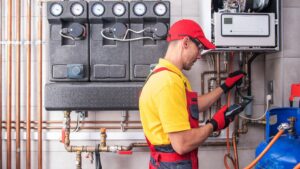Key Takeaways
- Heat pipe technology leverages phase change and capillary action to efficiently transfer heat, making it a versatile solution for thermal management across multiple industries.
- Key components include the evaporator, condenser, and wick structure, which work together to facilitate rapid heat absorption and dissipation, ensuring optimal system performance.
- Applications span from electronics cooling to renewable energy systems, showcasing the adaptability of heat pipes in managing thermal loads and enhancing energy efficiency in various environments.
- The advantages of heat pipes include high efficiency, compact design, and reliability, which contribute to reduced maintenance and improved durability compared to traditional cooling methods.
- Future trends indicate advancements in materials and designs, such as miniaturization and integration with renewable systems, which will further enhance the capabilities and applications of heat pipe technology.
In an age where energy efficiency and thermal management are paramount, heat pipe technology stands out as a revolutionary solution. This innovative method utilizes the principles of phase change and capillary action to transfer heat with remarkable efficiency. Whether in electronics cooling or HVAC systems, heat pipes are becoming indispensable for optimizing performance and reliability.
As industries seek to reduce energy consumption and enhance thermal regulation, understanding heat pipe technology is crucial. It offers a compact and lightweight alternative to traditional cooling methods, making it ideal for various applications. By harnessing the power of heat pipes, engineers and designers can create systems that not only perform better but also contribute to a more sustainable future.
Heat Pipe Technology
Heat pipe technology functions as a highly efficient thermal management system that utilizes phase change and capillary action. The design typically consists of a sealed container filled with a liquid working fluid, often water or a refrigerant. When one end of the heat pipe absorbs heat, the fluid vaporizes, absorbing significant energy.
Key Components
- Evaporator Section: This segment absorbs heat, causing the working fluid to vaporize.
- Condenser Section: This section dissipates heat, allowing the vapor to condense back into liquid.
- Wick Structure: This structure facilitates the movement of the liquid back to the evaporator through capillary action.
Operation Principles
Heat pipes operate based on three core principles:
- Phase Change: The liquid turns into vapor at high temperatures, effectively transferring heat.
- Capillary Action: The wick’s structure efficiently draws the condensed liquid back to the evaporator.
- Thermal Conductivity: The high thermal conductivity of heat pipes allows for rapid heat distribution.
Applications
 Heat pipe technology finds its application across various industries, including:
Heat pipe technology finds its application across various industries, including:
- Electronics: Heat pipes manage thermal loads in devices, enhancing lifespan and performance.
- HVAC Systems: These systems utilize heat pipes for effective temperature regulation and energy savings.
- Spacecraft: They provide reliable thermal control in extreme conditions.
Advantages
Utilizing heat pipe technology presents several benefits:
- Efficiency: It transfers heat more efficiently than conventional cooling methods.
- Compactness: Their small size makes them suitable for space-constrained applications.
- Reliability: With no moving parts, heat pipes offer durability and minimal maintenance.
Overall, heat pipe technology plays a crucial role in modern thermal management solutions, aligning with industries’ objectives of improving energy efficiency and sustainability.
Principles of Heat Pipe Operation
Heat pipe operation relies on the principles of phase change, capillary action, and thermal conductivity to achieve effective heat transfer. Understanding these mechanisms is vital for harnessing the full potential of heat pipe technology in various applications.
Heat Transfer Mechanisms
Heat transfer in heat pipes occurs through two primary mechanisms: evaporation and condensation.
- Evaporation: In the evaporator section, the liquid working fluid absorbs heat, converting into vapor. This phase change occurs rapidly due to the high thermal conductivity of the heat pipe material.
- Condensation: In the condenser section, vapor loses heat and condenses back into liquid. The heat is typically dissipated to a cooler surface, completing the cycle by returning the working fluid to the evaporator.
Capillary action drives the liquid back to the evaporator through the wick structure. This continuous cycle enables efficient thermal management, facilitating effective heat distribution across various applications.
Working Fluid Selection
Selecting the appropriate working fluid is crucial for optimizing a heat pipe’s performance. The following factors influence fluid selection:
- Boiling Point: Fluids with boiling points suited to operating temperatures enhance efficiency. For example, water is commonly used for lower temperature applications, while liquids like ammonia serve better in higher temperature environments.
- Thermal Conductivity: High thermal conductivity improves heat transfer rates. Fluids with excellent thermal properties minimize thermal resistance during phase changes.
- Viscosity: Low viscosity fluids ensure rapid movement within the wick, improving the return flow to the evaporator.
- Compatibility: Fluid compatibility with construction materials prevents degradation and leaks. Selecting non-corrosive fluids extends the lifespan of the heat pipe.
- Specific Heat Capacity: Fluids with high specific heat capacity can absorb and release more heat without large temperature changes, enhancing thermal stability.
Applications of Heat Pipe Technology
Heat pipe technology finds extensive applications across numerous fields due to its efficient heat transfer capabilities. It serves as a vital component in improving performance and energy management in various systems.
Electronics Cooling
Electronics cooling heavily relies on heat pipe technology. It effectively manages heat in compact spaces, enabling more powerful electronic components. Heat pipes dissipate heat from microprocessors, GPUs, and other high-performance devices, ensuring optimal operating temperatures. This technology enhances reliability, extends the lifespan of components, and reduces the risk of thermal failure.
Renewable Energy Systems
 Renewable energy systems employ heat pipe technology to maximize efficiency. In solar thermal applications, heat pipes enhance heat transfer from solar collectors to fluid systems. The rapid thermal response significantly increases energy conversion efficiency in photovoltaic panels. Furthermore, heat pipes aid in thermal regulation in biomass and geothermal systems, facilitating efficient energy use and promoting sustainability.
Renewable energy systems employ heat pipe technology to maximize efficiency. In solar thermal applications, heat pipes enhance heat transfer from solar collectors to fluid systems. The rapid thermal response significantly increases energy conversion efficiency in photovoltaic panels. Furthermore, heat pipes aid in thermal regulation in biomass and geothermal systems, facilitating efficient energy use and promoting sustainability.
Spacecraft Thermal Management
Spacecraft thermal management benefits from the unique properties of heat pipes. They maintain consistent temperatures in extreme environments, supporting the operation of sensitive instruments and systems aboard spacecraft. Heat pipes manage heat generated by onboard equipment, ensuring effective thermal control. Their lightweight and compact design make them ideal for space applications, where every ounce of weight counts.
Advantages and Limitations of Heat Pipes
Heat pipes offer significant benefits along with certain challenges. Understanding these aspects is critical for effective application in various industries.
- High Efficiency: Heat pipes provide exceptional thermal conductance, allowing rapid heat transfer with minimal temperature differences. This characteristic makes them suitable for high-performance applications.
- Compact Design: Heat pipes are lightweight and compact, making them ideal for space-constrained environments, such as in electronics or aerospace applications.
- Reliability: The absence of moving parts ensures durability and reduces maintenance requirements. Heat pipes operate effectively over extended periods without performance degradation.
- Versatility: Heat pipes accommodate various working fluids and can operate in extreme temperatures, enhancing their usability across diverse applications, including renewable energy and HVAC systems.
Future Trends in Heat Pipe Technology
Heat pipe technology continues to evolve, promising advancements that enhance performance and application versatility across various industries. Key trends shaping the future include:
- Innovative Materials: Researchers are exploring advanced materials like graphene and carbon nanotubes to improve thermal conductivity and durability. Such materials can enhance heat pipe efficiency and thermal capacity significantly.
- Miniaturization: The trend towards miniaturizing electronic components drives demand for smaller heat pipes that maintain efficiency. Micro heat pipes will cater to compact devices, such as smartphones and ultra-thin laptops, without compromising thermal management.
- Integration with Renewable Energy: Heat pipes are increasingly integrated into renewable energy systems. They promote efficiency in solar thermal collectors and support heating applications, aligning with global sustainability goals.
- Adaptive Cooling Systems: Development of adaptive cooling systems utilizing heat pipes can adjust to varying energy loads. These systems optimize thermal management based on real-time data, improving energy efficiency in HVAC applications.
- Enhanced Capillary Structures: Research into advanced wick designs focuses on improving capillary action, thereby enhancing heat transfer rates. Tailored wick structures can optimize fluid movement and storage, further boosting performance.
- Flexible and Hybrid Heat Pipes: Emerging flexible heat pipe designs enable integration into non-traditional surfaces. Hybrid systems combining heat pipes with other cooling technologies can optimize performance in specific applications, enhancing overall thermal management.
- Smart Thermal Management: The integration of IoT technology into heat pipe systems facilitates smart thermal management solutions. Sensors can monitor performance, enabling predictive maintenance and energy-saving strategies.
- Environmental Impact Focus: A greater emphasis on using non-toxic, eco-friendly working fluids addresses environmental concerns. Heat pipe technology will evolve to reduce ecological footprints while maintaining efficiency.
Advancements in these areas signify the expanding role of heat pipe technology in various sectors, highlighting its potential to meet future thermal management demands effectively.
Transformative Solution For Thermal Management
Heat pipe technology stands out as a transformative solution for thermal management across diverse industries. Its ability to efficiently transfer heat while maintaining a compact design makes it indispensable for applications in electronics cooling and renewable energy systems. As industries continue to prioritize energy efficiency and sustainability, the advancements in heat pipe design and materials will play a crucial role in meeting these demands.
The ongoing exploration of innovative approaches, such as miniaturization and smart thermal management, positions heat pipes at the forefront of future technological developments. By embracing these trends, industries can enhance performance, reliability, and environmental sustainability, ensuring that heat pipe technology remains a vital component of modern engineering solutions.

